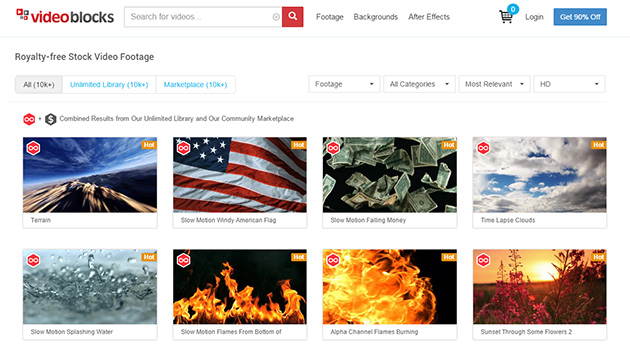
On 4K, Virtual Reality, the Competition, and the State of Stock
Since Joel Holland launched VideoBlocks in 2010, his Netflix-like subscription model for all-you-can-eat stock footage has made an aggressive play in the stock marketplace. The company became a resource for content creators who wanted a broad no-muss, no-fuss library of footage that they could use on demand. This year, VideoBlocks launched a second, more traditional stock marketplace where customers pay individually for clips from marketplace contributors, with VideoBlocks taking a zero-percent commission on the deal. (Users must be VideoBlocks subscribers to buy clips in the marketplace.) We asked Holland about trends in stock footage, the hype around 4K, VR, and 360-degree video, and what the next frontier for stock providers might look like.
It's 2015, and we're in the middle of some massive transitions in this industry. Let's talk about how these are affecting the market for stock.
I think the first big trend is 4K. Now, 4K has been around for a long time. We've been offering 4K content for three or four years, but this year it's becoming mainstream. We saw that at NAB, with all the different cameras and capture devices supporting 4K. And 4K TV shipments grew 400% in Q1, which is important — we may have devices that capture 4K, but what are you going to watch it on? And the final piece will be 4K production.
So what are you seeing from your customers?
Customers, especially high-end customers, are trying to build their productions in 4K. Many of them are down-resing to HD for distribution, but they're starting at the highest quality possible. Let's say they're looking for New York City footage. They're going to grab that in 4K as opposed to HD. Consumption of 4K content for us has gone up hundreds of percentage points over the year. It's the high-end users, the first movers in the market, who are starting to use it. So 2015 has solidified that 4K is no longer the future. It's the present. And by 2016, it will just be normal. Fast-forward a couple of years, and HD will drop off just like SD dropped off. It was probably a year ago that we cleansed our archive of SD content, and we're probably just a couple of years away from the purging of HD. As a shooter, you want to make sure you shoot in 4K, and as an editor, you want to create in 4K, and one day HD will be irrelevant.
Well, there are qualitative differences in the footage, too. Footage captured in the early days of HD doesn't really hold up against what a good camera can capture now, and 4K must be a similar story.
I think what tends to happen with new formats and new resolutions is that people go out and are most focused on capturing with their new toy rather than focusing on capturing a good shot. It's not, "Hey, let's go get some amazing footage of Yosemite." It's more, "Hey, we have a drone! Let's go play with our new toy." It's like what you're seeing now with 360-degree video. Go on YouTube, and the videos getting millions of views are, for all intents and purposes, pretty crappy. It has nothing to do with quality. It's just an interesting new format. So the earliest 4K shooters might not have been taking the time to compose really good shots. We were shooting our first footage with the Red One, and I think it holds up. It's great technology, and it was a raw format even back then. But people look at technology as the answer when it's really just the vehicle.
Well, you just mentioned virtual reality and 360-degree video. Do you see a market for immersive stock footage?
I thinking offering 360-degree footage and/or VR — they are very different, but right now we're so early on that people are lumping them together. There's a difference between 360-degree 2D and 360 stereoscopic. Everything you're watching on YouTube is 2D. What all the buzz is about is the Oculus and similar devices that are oging to support truly stereo 360-degree VR video. My guess is that 360-degree video has novelty value right now, but I think it will wear off. I doubt that we'll ever be creating 2D 360-degree video as stock. On the stereo side, will 3D VR footage ever be in high demand, like 4K? The answer is no. The world of people who will buy these headsets and get into this immersive experience is going to be a niche market. I don't personally think VR is ever going to become mainstream. So my guess is yes, we will offer VR footage but no, it will never be the same opportunity as 4K. Not even close.
With the rise of OTT delivery, we're seeing a dramatic expansion in the channels through which video can be delivered and an increase in the number of people creating video programming. Is that good for your business?
Well, yes. It's not a zero sum game, where people are turning off TV and turning onto the web. There is a slight decline in TV viewership, but also an increase in mobile video and desktop viewership. Video consumption is going to grow a lot. And everyone has the ability to become a YouTube superstar. Everyone has the ability to afford a 4K camera. Every outlet, from Amazon and Netflix to YouTube, Instagram and Vine, are all just broadening the interest in creating video. And a percentage of those creators are finding VideoBlocks to be an affordable way to make stories better.
OK, so how are you reacting to these changes as a company?
VideoBlocks now has two libraries. We have the unlimited library. That's content that we go out and acquire, or invest in creating. We now source that pretty much exclusively in 4K.It's a hard line — if we're buying content or creating content, we're originating it or purchasing it in 4K. HD is the majority of our content, but 4K is here now. Now, the marketplace is a total free market, and it's been very interesting to watch. Back in April, we launched the marketplace at NAB, announcing we'd give contributors 100 percent of the profit from every clip they sell. To say that's been well received is a giant understatement. More than 5,000 contributors have signed up and submitted more than 500,000 clips to the marketplace. It took Shutterstock five years to get to a million, and it took Pond5 five or six years to get there. We'll do it in under a year. So the market responded: We want a bigger piece of the pie, and VideoBlocks provides that.
The majority of content people are uploading is still HD, but the new content being created and uploaded includes a lot of 4K. That trend will continue. In a year, we'll see an equal amount, if not a majority, of new content coming in at 4K. You can upload in 4K and we will automatically downres it to HD. If someone buys 4K, it's $199 that goes into your pocket, and if they buy HD it's $49 into your pocket. That's what I love about marketplaces. If the supplier sees that they're making three or four times as much money on the 4K clips, they will realize it behooves them to put up as much 4K as possible to have that shot at making $199.
You have an innovative model, but competition is increasing. For example, there's Adobe Stock. That's coming from a company that is strongly interested in increasing its subscription revenues through stock footage, and they have the ability to tightly integrate their stock libraries in some very popular tools. What effect are aggressive competitors like Adobe going to have on your business?
I welcome the competition. Adobe is going to help put stock media on the map. You and I have known about stock video and photography for ages, but the mainstream market buying cameras and shooting videos and becoming YouTube superstars don't necessaily know that stock media is an asset category that exists. Adobe is doing a lot to educate the market, so I love that. To date, they do not have much of a video offering, if any, but that will eventually change and I welcome that, too. It keeps us on our toes. But they are in the Shutterstock camp of keeping the majority of every sale. And our contributors appreciate it when we say, "You deserve to be better compensated."
But the thing that's overblown is how important integration into Premiere and Photoshop is. It's not that important. It's quality, not method of consumption. People are going to look for high-quality stock clips. If that means they have to used a tabbed browser approach to find it, well, that's easy. But going through Photoshop or Premiere? Unless that content is way better, I don't see why that would be a better experience. It's hard to match a web browser for ease of use. Adobe is going to be a real competitor that has a meaningful impact on the stock space, but all the hubub about incorporating stock media into their programs is overblown.
What are some next-generation trends that you see driving the market in the future?
Live video streaming has been around for years. It's nothing new, but it's exploding. Periscope has 10 million registered users wtaching 40 years of video a day. It's crazy. And the reason live streaming came in hot in 2015 and will continue to be hot for a while is that everyone has a phone that can capture high-quality video, and cell networks using LTE can transmit that video like never before. Social graph integration with Twitter — and Facebook is getting into this, too — so that you can notify your whole network that you're streaming is changing things like never before. Live streaming video is a little hyped up right now, but I don't think it's going away. Does someone in our space decide there's a way to provide stock elements for live streams, using plug-ins or apps to put title areas on your video, use filters, and add sound effects and transitions, almost like live broadcast tools? I don't know. But it's interesting to think about.
For sure. Thanks for your insight into the evolving market. Any parting words?
The trend of giving back so much revenue to the contributors? I hope that's really going to take hold in the industry. For too long, contributors were not paid enough. I like that it was VideoBlocks that changed that. We took an aggressive stance, we fired that shot, and I think you're going to see, throughout the industry, higher commissions paid to contributors. I think that's great for the industry and great for content. Whenever I can, I like to close with this line: We've all heard content is king, and if that's the case, we feel the creator should be treated like royalty.
Sections: Business
Topics: Q&A 4K adobe stock joel holland live streaming stock footage videoblocks VR
Did you enjoy this article? Sign up to receive the StudioDaily Fix eletter containing the latest stories, including news, videos, interviews, reviews and more.

As a creator of stock footage and a marketplace contributor to VideoBlocks I applaud Joel and his team for thinking outside the box and creating a win-win-win for the agency, the buyer AND the contributor. That’s a breath of fresh air the creators in this industry desperately needed.